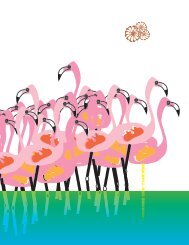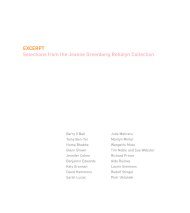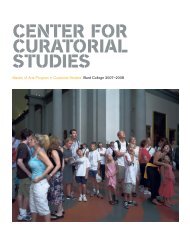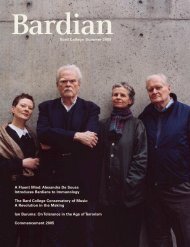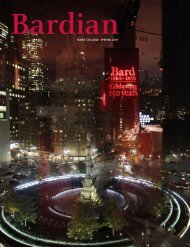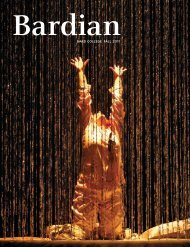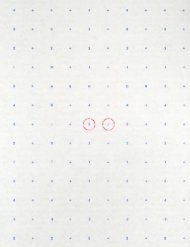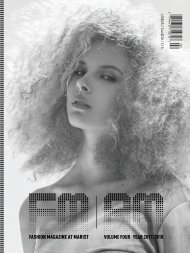FLLAC EXH CAT 2008 081408
You also want an ePaper? Increase the reach of your titles
YUMPU automatically turns print PDFs into web optimized ePapers that Google loves.
EXCERPT<br />
Selections from the Jeanne Greenberg Rohatyn Collection
EXCERPT<br />
Selections from the Jeanne Greenberg Rohatyn Collection<br />
Barry X Ball<br />
Tamy Ben-Tor<br />
Huma Bhabha<br />
Glenn Brown<br />
Jennifer Cohen<br />
Benjamin Edwards<br />
Katy Grannan<br />
David Hammons<br />
Sarah Lucas<br />
Julie Mehretu<br />
Marilyn Minter<br />
Wangechi Mutu<br />
Tim Noble and Sue Webster<br />
Richard Prince<br />
Aïda Ruilova<br />
Laurie Simmons<br />
Rudolf Stingel<br />
Piotr Uklanski
Excerpt: Selections from the Collection of Jeanne Greenberg Rohatyn<br />
September 26, <strong>2008</strong> – January 4, 2009<br />
This catalogue has been published in conjunction with the exhibition Excerpt: Selections<br />
from the Jeanne Greenberg Rohatyn Collection, organized and presented at the Frances<br />
Lehman Loeb Art Center, Vassar College, and curated by Mary-Kay Lombino.<br />
ISBN # 978-0-9820606-0-5<br />
Designed by Francie Soosman<br />
Printed by Quality Printing Company, Pittsfield Massachusetts in an edition of 3,000 copies.<br />
Text © Vassar College, <strong>2008</strong>. Images © the artists.<br />
No part of the contents of this book may be reproduced, in whole or in part, without the<br />
permission of the publisher.<br />
The Frances Lehman Loeb Art Center<br />
Vassar College, Box 703<br />
124 Raymond Avenue<br />
Poughkeepsie, NY 12604-0703<br />
Telephone 845 437 5632<br />
Fax 845 437 5955<br />
http://fllac.vassar.edu<br />
Contents<br />
Photo credits<br />
John Smith, page 2, 3, 8, 10<br />
Paul Smith, page 2, 3, 8, 10<br />
Ringo Smith, page 2, 3, 8, 10<br />
George Smith, page 2, 3, 8, 10<br />
John Smith, page 2, 3, 8, 10<br />
Paul Smith, page 2, 3, 8, 10<br />
Ringo Smith, page 2, 3, 8, 10<br />
George Smith, page 2, 3, 8, 10<br />
John Smith, page 2, 3, 8, 10<br />
Paul Smith, page 2, 3, 8, 10<br />
Ringo Smith, page 2, 3, 8, 10<br />
George Smith, page 2, 3, 8, 10<br />
John Smith, page 2, 3, 8, 10<br />
Paul Smith, page 2, 3, 8, 10<br />
Ringo Smith, page 2, 3, 8, 10<br />
George Smith, page 2, 3, 8, 10<br />
Acknowledgments 5<br />
Director’s Foreword 6<br />
An Interview by Mary-Kay Lombino 8<br />
No.s 17<br />
Exhibition Checklist 68
Acknowledgments<br />
It is with great enthusiasm that The Frances Lehman Loeb Art Center at Vassar College<br />
presents the exhibition Out of Shape: Stylistic Distortions of the Human Form in Art from<br />
the Logan Collection the first exhibition that focuses exclusively on works on paper from<br />
this outstanding collection of the art of our time. We are honored to have the opportunity<br />
to work with Vicki and Kent Logan to bring this aspect of their work to the public and we<br />
are deeply indebted to them for sharing their collection as well as their time, energy, passion,<br />
and expertise at every step of the way. It is their vision, generosity, and commitment<br />
to supporting artists in whom they believe that allows us to bring this extraordinary artwork<br />
to our audience and to enrich the lives and educations of the students at Vassar<br />
College.<br />
While all of the loans for this exhibition originate from the Logan Collection,<br />
several works are fractional and promised gifts to the San Francisco Museum of Modern<br />
Art and the Denver Art Museum. We would like to thank Neal Benezra, Director of San<br />
Francisco Museum of Modern Art along with Kelly Parady, Assistant Registrar for her<br />
coordination of the loans and Lewis Sharp, Director of the Denver Art Museum with Jill<br />
Desmond, Assistant Curator and Lori Iliff, Registrar who both assisted in coordinating<br />
loans. Robyn Wiley, Collection Manager for the Logan Collection, provided valuable information<br />
and assistance with all aspects of the exhibition from its inception.<br />
Jeanne Greenberg Rohaty<br />
Standing in front of TK<br />
We are grateful to George Laws for his skillful design of all of the exhibition materials<br />
including this catalogue and to Janet Allison who coordinated the publication. We would<br />
also like to recognize the entire staff of the Frances Lehman Loeb Art Center for their support<br />
and dedication, especially Registrar Joann Potter, who expertly handled the formidable<br />
task of arranging the crating and shipping of the work.<br />
And finally, we would like to thanks the artists whose work is included in Out of Shape for<br />
their remarkable artworks and insightful contributions to contemporary culture.<br />
4<br />
5
Director’s Foreword<br />
When the Vassar College Art Gallery first opened its doors in the mid-nineteenth century,<br />
its collection was primarily composed of contemporary art—admittedly academic painting<br />
before there was really such a thing as the avant-garde, but contemporary nonetheless.<br />
Over the ensuing 140 years, what was once contemporary grew to be historical and Vassar’s<br />
curriculum in the history of art grew accordingly. However, all along the way the Vassar<br />
academic emphasis on “going to the source,” included many art instructors’ insistence that<br />
their students be aware of contemporary artistic movements. Visits of contemporary artists to<br />
campus whether Le Corbusier, Alexander Calder, Sol LeWitt, or Jenny Holzer have brought<br />
life to the teaching of art as an ever-evolving historical discipline rooted in the present. At<br />
what is now the Frances Lehman Loeb Art Center, we have benefited over the years from<br />
Vassar graduates’ pursuit of modern art as collectors and, eventually, donors to the collection.<br />
Paintings in our collection by Francis Bacon, Jackson Pollock, and Mark Rothko, for<br />
example, were acquired by their donors while the artists, themselves were still young or in<br />
mid-career and before they made their permanent impact on the history of art.<br />
Since we are primarily an institution that collects art that can be interpreted historically for<br />
our students, it is only recently in this museum’s history that we have had the luxury of<br />
having a curator on staff who is a specialist about the art of today. Mary-Kay Lombino,<br />
who joined the Frances Lehman Loeb Art Center in the autumn of 2005, has played an<br />
important role in focusing the institution’s attention on the important art movements of the<br />
present while serving as a resource for alumni who are engaged in the collecting of contemporary<br />
art. It is self-evident that we would not be able to mount the present exhibition Out<br />
of Shape: Stylistic Distortions of the Human Form in Art from the Logan Collection without<br />
the cooperation of Vicki Logan, Vassar class of 1968 and her husband Kent Logan. But<br />
it is equally true that, had we wished to undertake this project earlier, the curatorial expertise<br />
would not have been in place to bring it to fruition.<br />
tion that has rigorously maintained standards. Hence, the results are far more than a list of<br />
randomly selected brand-name trophies snagged from the intensely competitive contemporary<br />
art market. It is, instead, a rigorously vetted visual and intellectual exercise that has<br />
taken, at times, considerable risks but has often charted exciting new territories. Their forays<br />
into the new generation of British and Chinese artists, for example, have yielded important<br />
results in exposing a greater public to these vibrant contemporary centers. The Logans have<br />
had the courage to rely on their instincts in forming their collection. In the museum world,<br />
they are known as “activist” collectors who insist that their involvement actually yields a<br />
contribution to the collective cultural consciousness. We are very grateful to both of them for<br />
allowing us to celebrate their accomplishments and share a portion of the results with our<br />
students and faculty.<br />
James Mundy<br />
The Anne Hendricks Bass Director<br />
The Logan Collection is rightly world famous. It has been the focus of an intelligent and<br />
passionate pair of collectors who have collaborated from the outset on assembling a collec-<br />
6<br />
7
The Pleasure of Looking<br />
an interview with Jeanne Greenberg Rohatyn by Mary-Kay Lombino<br />
Art advisor, curator, and collector Jeanne Greenberg Rohatyn founded Salon 94 in the first<br />
floor of her Manhattan home in 2002, to be an experimental project space for emerging<br />
and mid-career contemporary artists. Much of her own collection can be found on display<br />
just upstairs, in her family’s living space. The works in her private collection reflect a personal<br />
connection to the artists she supports, and reveals how her passion for art permeates both<br />
her private and professional life. While the work shows evidence of a diverse set of social,<br />
political, ethnic, and intergenerational interests, it is bound together in this distinguished<br />
collection, which illustrates the personal preferences of an experienced collector with a<br />
well-trained eye, but also reveals a rare intimacy and deep understanding of the power<br />
of the art of our time.<br />
MKL What were your first memorable art experiences as a child?<br />
JGR In 1970, a truck pulled up to our house, in suburban St. Louis, and unloaded a large<br />
crate, in it a Morris Louis painting. Squeezed into our living room—a small cozy space<br />
with over stuffed madras couches, walled with taxidermy animal heads, this painting was<br />
an alien landed. My mother looked at this veiled monster, and announced that either the<br />
Florine Stettheimer<br />
TK<br />
8<br />
9
house or the painting had to go. The following day, my father went out and bought an<br />
enormous Tudor house.<br />
He hired architectural students at Washington University to renovate—they built thick sheet<br />
walls to attach to the historic wood panels for hanging. It was a house bought for art,<br />
sparingly outfitted with just the essentials. Keeping with the minimalist tenets of the time,<br />
the walls were gallery white. Yet the house itself, built after the 1904 worlds fair, had its<br />
own nature—it was detailed ornately with carved lions on its grand stairwell (the original<br />
owner’s name was Lionberger Davis), coiffured ceilings and a sunroom with leaded glass<br />
windows. The pairing of my parents emerging collection and this house gave me a solid<br />
sense that art pulls one out of the domestic. Yet, art always needs a lot of help … and the<br />
character of a place allowed the art to breathe in a dynamic way.<br />
In order to collect full time, my father became an art dealer in 1971. He showed and collected<br />
the artists of his generation: Roy Lichtenstein and Andy Warhol followed by Richard Serra,<br />
Donald Judd and Dan Flavin. In 1975, Warhol sent The Greenberg Gallery a role of purple<br />
Mao wallpaper for his upcoming exhibit there. My father brought it home and used it to<br />
wallpaper the powder room. During the evening’s celebrations, a shy wigged Warhol hung<br />
out in this bathroom, signing Campbell’s Soup cans nicked from our pantry by my parents’<br />
friends. I stood below him—and when he had a break he would doodle bananas on a napkin<br />
for me. It was finally at Vassar that I saw the album cover of the Velvet Underground.<br />
My two sisters and I each selected a work of art for our rooms—I chose a painting by John<br />
Tuttle (a now obscure artist)—a shaped canvas with the word ART scripted in the center<br />
and dollar signs doodled in the four corners. Its symbolism clearly foreshadows my life in<br />
art and commerce.<br />
MKL As a student at Vassar, you studied Art History. Is there anything in particular about<br />
your college education that informs your relationship with art today?<br />
Stettheimer Salon Recreation<br />
TK<br />
JGR The museum was always a great walk-through. There, I discovered the Florine<br />
Stettheimer who became the inspiration for an exhibition I mounted years later (199-) in<br />
11
the green room of the Gramercy Park Fair, entitled TK. I was fascinated with the pre-war<br />
attitudes of the Stettheimer sisters and their famed salon at Alwyn Court. They represented<br />
great contradictions from frivolous to the serious—Duchamp taught the heiresses French<br />
while they sat for manicures; yet each were devoted to her own discipline (writer, painter,<br />
dollhouse maker). The salon was occasion for Florrine to dramatically unveil her paintings,<br />
revealing her fantastic paintings of and to her artistic friends. Yet, her ultimate place as<br />
hostess unnerved me. We recreated her salon in spirit—combining works by Warhol, Jeff<br />
Koons and a then emerging Elizabeth Peyton, and borrowed from Columbia University<br />
some of Stettheimer’s greatest paintings—including her self-portrait as the nude Olympia.<br />
Imitating her aesthetic, we covered the walls with cellophane, and Virgil Thomas was<br />
played on the piano.<br />
MKL How did you begin collecting?<br />
JGR I collected what my parents did not. It started with ceramics (my father, a hard core<br />
minimalist, would have never purchased what he stills consider to be tchotki) —and moved<br />
onto artists of my generation. Whenever I make money, it goes towards an art purchase. I<br />
had a slow start and I regret not having starting earlier. Joe Pulitzer, Jr. once described to<br />
me his connoisseur classes at Harvard, where the art history professor would bring in each<br />
week an actual work of art to study—Alberto Giacometti, Auguste Rodin, Èdouard Manet,<br />
and so on. Often the young men in the class, many heirs to great fortunes, would track<br />
down and buy the artworks. Imagine, in 1936, as a Harvard undergraduate, he bought<br />
Amedeo Modigliani’s Elvira Resting at a Table! That is a good beginning.<br />
MKL What attracted you to contemporary art?<br />
JGR I like being in dialogue with artists. Many are among my close friends. Gregory<br />
Crewdson, whom I met shortly after moving to New York in 1990, and I imagined a show<br />
called Suburbia while chatting about Steven Spielberg movies and our favorite short story,<br />
The Swimmer by John Cheever. And, while this project was never realized, in 1999 we<br />
ultimately co-curated Another Girl/Another Planet, which introduced young narrative<br />
photography. The show grew from comparing studio visits—Gregory teaching at Yale,<br />
TKkkkkkkkkkkkkkk<br />
TK<br />
12<br />
13
TKkkkkkkkkkkkkkk<br />
TK<br />
and me in New York and London. I continue to work with Katy Grannan and Malerie<br />
Marder, whose work was featured. Inspired by this young work, Gregory later began to<br />
place figures in his own landscape photographs.<br />
MKL What kinds of qualities do you look for in an artwork that you are considering for<br />
purchase?<br />
JGR An element of surprise. The works must have beauty, concept, and the pleasure of<br />
looking. I also seek out raw talent in an artist.<br />
MKL Once you begin collecting a particular artist’s work, do you form a bond to that<br />
artist, or do you feel a certain commitment to continuing to support him or her?<br />
JGR It is a luxury to support an artist throughout his or her career. As a patron of young<br />
artists, I often buy early on, yet I am priced out of their market soon thereafter. I have<br />
made a commitment to a handful of artists, whom I will continue to support. I will keep<br />
working to afford their work.<br />
Katy Grannan makes a portrait of our children every year that we use as our signature<br />
holiday card. We also collect her work in depth.<br />
MKL As you live with an artwork over a long period, how does your relationship with that<br />
artwork evolve with time?<br />
JGR At home, I regularly move artworks around, playing with their context in relation to<br />
other works. Likewise, artwork in this exhibition and its Vassar installation will acquire<br />
new meaning. The Richard Prince car hood shown next to a Mark Rothko painting will<br />
look classical and monastic—yet at home, next to an Adam McEwen gum painting and a<br />
Takashi Murakami painting—it looks dangerous, Pop, and trashy. Sometimes it takes years<br />
for a work to look classic—with other works it happens overnight. When I bought Sara<br />
Lucas’ Notorious Dream, I instantly thought about it in relation to Hans Bellmer and to<br />
15
Pablo Picasso portraits of seated woman—yet in our living room—these are mere passing<br />
historical notations to a deeply radical work.<br />
MKL Are there any works in your collection that are difficult to live with?<br />
JGR Yes, Reneke Diekstre New Mothers photographs. These fill everyone with discomfort—<br />
especially men. When they were hung in our living room, even seasoned curators turned<br />
their backs on it. These are now a promised gift to The Museum of Modern Art.<br />
MKL As a patron and producer of many artists’ projects, how do you see your role in the<br />
artistic vision of an artist?<br />
JGR I like to produce projects that are performative in nature. I am planning with Art<br />
Production Fund a Sylvie Fleury Fluxus Symphony at The Armory Show this February.<br />
Artists often find Salon 94 to be a safe place to make new work. Perhaps because it is just<br />
off the grid enough that it allows them to experiment. Wangechi Mutu made her first largescale<br />
installation there, and for the past several years Tamy Ben-Tor has used it as a space<br />
to develop her characters. These projects are non-commercial in nature.<br />
MKL I noticed that some of the works in your collection are very personal in subject matter.<br />
Some examples are the Katy Grannan photographs and the Barry X Ball portrait of you.<br />
Are these commissioned works?<br />
JGR Yes, my husband, commissioned several artists to make works for me as a fourtieth<br />
birthday gift. He asked artists with whom I have worked in the past.<br />
MKL Are there any artworks that you wish you had bought, but are no longer available?<br />
JGR Many! While they are seemingly in opposite camps—the two artists who have influenced<br />
me most are David Hammons and Jeff Koons. I am sorry that I do not own more of<br />
their works. I have been lucky, as many have passed through my hands as a dealer.<br />
New Mothers<br />
TK<br />
16<br />
17
The Collection<br />
18<br />
19
No. 1<br />
Barry X Ball<br />
The artist, taking the life-cast head of his New York gallerist as a jumping-off point, in<br />
a concerted effort to reinvigorate the sub-genre of romantic portrait sculpture, has here<br />
conjoined his signature fever-pitch execution intensity and a newfound conceptual tenderness.<br />
Realized as a mirror-image of the subject, at 85% scale, in an exceptional specimen of<br />
dramatically-figured, exuberantly- colored translucent onyx, exhibiting a layered surface<br />
suffused with a ‘sfumato’ overlay of foliate relief and coincident miniscule diagonal/radial<br />
flutes, the stony surrogate captures, in soft Galatean contravention of its obdurate materiality,<br />
a moment of poignant reverie.The artist-designed integral / modular base, it’s tapering<br />
parabolic sweep flowing into the sculpture’s glass-polished flute stem (which, in turn,<br />
terminates in a silhouetted arboreal fringe), conceived in parallel with the sculpture, preciselyfabricated<br />
in stainless steel, limestone, acrylic-spray-lacquered aluminum and wood (and a<br />
variety of subsidiary materials) by a studio-coordinated consortium of disparate fabricators,<br />
is reminiscent, alternately, of traditional ‘socles’ and mid-20th-century Modernist furniture<br />
pedestals. The resultant deceptively-diminutive ensemble, created with deep reverence for<br />
and specific focus on the history of sculpture, makes an expansive case for the critical<br />
reconsideration of prevailing contemporary practice, while simultaneously probing both<br />
the subject’s psychology and her complex relationship to the artist, 2007-<strong>2008</strong><br />
Mexican Onyx<br />
20<br />
21
No. 2<br />
Tamy Ben-Tor<br />
Exotica, The Rat and The<br />
Liberal, 2005<br />
No. 3<br />
Tamy Ben-Tor<br />
Exotica, The Rat and<br />
The Liberal, 2005<br />
22<br />
23
No. 5<br />
Tamy Ben-Tor<br />
The Tea Lover, year<br />
24<br />
25
No. 8<br />
Glenn Brown<br />
Holy Virgin, 2003<br />
No. 7<br />
Huma Bhabha<br />
Sleeper, 2005<br />
26<br />
27
No. 9<br />
Jennifer Cohen<br />
Grey Line in Three Parts (i), <strong>2008</strong><br />
28
No. 10<br />
Benjamin Edwards<br />
Decoherence, 2001<br />
31
grannan<br />
grannan<br />
No. 11<br />
Katy Grannan<br />
Title TBA, 1999<br />
No. 12<br />
Katy Grannan<br />
Alexander Kay Rohatyn, November 2000, 2000<br />
32<br />
33
grannan<br />
grannan<br />
No. 13<br />
Katy Grannan<br />
Alexander Kay Rohatyn, YMCA, December 2001, 2001<br />
No. 14<br />
Katy Grannan<br />
Title TBA, 2002<br />
34<br />
35
grannan<br />
grannan<br />
No. 15<br />
Katy Grannan<br />
Alexander Kay and Colette Fay Rohatyn, December 2003, 2003<br />
No. 16<br />
Katy Grannan<br />
Alexander Kay and Colette Fay Rohatyn, November 2004, 2004<br />
36<br />
37
grannan<br />
grannan<br />
No. 17<br />
Katy Grannan<br />
Alexander Kay, Colette Fay and Clara Michele Rohatyn, November 2005, 2005<br />
No. 18<br />
Katy Grannan<br />
Alexander Kay, Colette Fay and Clara Michele Rohatyn, November 2007, 2007<br />
38<br />
39
No. 19<br />
David Hammons<br />
Hair Relaxer, 2001<br />
No. 20<br />
David Hammons<br />
Don’t Bite The Hand That Feeds, 1974<br />
40<br />
41
No. 21<br />
David Hammons<br />
Flight Fantasy, 1995<br />
42<br />
43
No. 23<br />
Sarah Lucas<br />
Stars at a Glance, 2007<br />
No. 22<br />
Sarah Lucas<br />
The Notorious Dream, 2004<br />
45
No. 24<br />
Julie Mehretu<br />
Dispersion, 2002<br />
46<br />
47
No. 25<br />
Julie Mehretu<br />
Excerpt (molotov cocktail), 2003<br />
No. 26<br />
Julie Mehretu<br />
Excerpt (riot), 2003<br />
48<br />
49
No. 28<br />
Marilyn Minter<br />
Nose Drops, 2007<br />
No. 27<br />
Marilyn Minter<br />
Glazed, 2006<br />
50<br />
51
No. 30<br />
Wangechi Mutu<br />
People in glass towers should not imagine us<br />
No. 29<br />
Wangechi Mutu<br />
The Mare, 2007<br />
53
No. 31<br />
Tim Noble and Sue Webster<br />
Twin Suicide, 2005<br />
54
No. 32<br />
Richard Prince<br />
Untitled (de Kooning), 2005<br />
No. 33<br />
Richard Prince<br />
Untitled (de Kooning), 2005<br />
56<br />
57
No. 34<br />
Richard Prince<br />
Untitled, <strong>2008</strong><br />
58<br />
59
No. 37<br />
Aïda Ruilova<br />
Alright, year<br />
No. 39<br />
Aïda Ruilova<br />
Alright, year<br />
No. 38<br />
Aïda Ruilova<br />
Alright, year<br />
60<br />
61
No. 36<br />
Aïda Ruilova<br />
Life Like, 2005<br />
No. 36<br />
Aïda Ruilova<br />
Cello, TK<br />
62<br />
63
No. 40<br />
Laurie Simmons<br />
The Music of Regret, 2006<br />
No. 40<br />
Laurie Simmons<br />
The Music of Regret, 2006<br />
64<br />
65
No. 40<br />
Laurie Simmons<br />
The Music of Regret, 2006<br />
66<br />
67
No. 42<br />
Rudolf Stingel<br />
Untitled (After Sam), 2005<br />
No. 41<br />
Rudolf Stingel<br />
Untitled, 1989<br />
68<br />
69
No. 43<br />
Piotr Uklanski<br />
The Nazis, 1999 (set B)<br />
70<br />
71
No. 43<br />
Piotr Uklanski<br />
The Nazis (Details), 1999 (set B)<br />
72 73
No. 44<br />
Piotr Uklanski<br />
Untitled (Carotid Artery), 2007<br />
74<br />
75
Exhibition checklist<br />
Dimensions are given in inches, height preceding width,<br />
preceding depth. All works are from the collection of<br />
Jeanne Greenberg Rohatyn unless otherwise indicated.<br />
Barry X Ball<br />
(b. 1955 Pasadena, California; lives in New York)<br />
1. The artist, taking the life-cast head of his New York<br />
gallerist as a jumping-off point, in a concerted effort to<br />
reinvigorate the sub-genre of romantic portrait sculpture,<br />
has here conjoined his signature fever-pitch execution<br />
intensity and a newfound conceptual tenderness. Realized<br />
as a mirror-image of the subject, at 85% scale, in an<br />
exceptional specimen of dramatically-figured, exuberantlycolored<br />
translucent onyx, exhibiting a layered surface<br />
suffused with a ‘sfumato’ overlay of foliate relief and<br />
coincident miniscule diagonal / radial flutes, the stony<br />
surrogate captures, in soft Galatean contravention of its<br />
obdurate materiality, a moment of poignant reverie.The<br />
artist-designed integral / modular base, it’s tapering<br />
parabolic sweep flowing into the sculpture’s glass-polished<br />
flute stem (which, in turn, terminates in a silhouetted<br />
arboreal fringe), conceived in parallel with the sculpture,<br />
precisely-fabricated in stainless steel, limestone, acrylicspray-lacquered<br />
aluminum and wood (and a variety of<br />
subsidiary materials) by a studio-coordinated consortium<br />
of disparate fabricators, is reminiscent, alternately, of<br />
traditional ‘socles’ and mid-20th-century Modernist furniture<br />
pedestals. The resultant deceptively-diminutive ensemble,<br />
created with deep reverence for and specific focus on the<br />
history of sculpture, makes an expansive case for the critical<br />
reconsideration of prevailing contemporary practice, while<br />
simultaneously probing both the subject’s psychology and<br />
her complex relationship to the artist, 2007-<strong>2008</strong><br />
Mexican Onyx<br />
13 3/8 x 6 3/8 x 7 1/8 in.<br />
Tamy Ben-Tor<br />
(b. 1975 Jerusalem, Israel; lives in New York)<br />
2. Title, year<br />
Medium<br />
duration<br />
3. Title, year<br />
Medium<br />
duration<br />
4. Title, year<br />
Medium<br />
duration<br />
5. Title, year<br />
Medium<br />
duration<br />
6. Title, year<br />
Medium<br />
duration<br />
Huma Bhabha<br />
(b. 1962 Karachi, Pakistan; lives in Poughkeepsie, New York)<br />
7. Sleeper, 2005<br />
Mixed media<br />
23 2/3 x 18 x 75<br />
Glenn Brown<br />
(b. 1966 Hexham, Northumerland, England;<br />
lives in London)<br />
8. Holy Virgin, 2003<br />
Oil on panel<br />
44 7/8 x 30 1/8<br />
Jennifer Cohen<br />
(b. YEAR PLACE; lives in Brooklyn, New York)<br />
9. Grey Line in Three Parts (i), <strong>2008</strong><br />
Wood, cellucly, cement, glue, leather shoe, fabric<br />
36 x 20 x 12 ?<br />
Benjamin Edwards<br />
(b. 1970 Iowa City, Iowa; lives in Washington, DC)<br />
10. Decoherence, 2001<br />
Acrylic, texture mediums, foam, spray paint<br />
96 x 144<br />
Katy Grannan<br />
(b. 1969 Arlington, Massachusetts; lives in San Francisco and<br />
New York)<br />
11. Alexander Kay Rohatyn, November 2000, 2000<br />
C-print<br />
16 x 11<br />
12. Alexander Kay Rohatyn, YMCA, December 2001, 2001<br />
C-print<br />
16 x 11<br />
13. Title TBA, 2002<br />
C-print<br />
16 x 11<br />
14. Alexander Kay and Colette Fay Rohatyn,<br />
December 2003, 2003<br />
C-print<br />
16 x 11<br />
15. Alexander Kay and Colette Fay Rohatyn,<br />
November 2004, 2004<br />
C-print<br />
11 x 16<br />
16. Alexander Kay, Colette Fay and Clara Michele Rohatyn,<br />
November 2005, 2005<br />
C-print<br />
11 x 16<br />
17. Title TBA, 2006<br />
C-print<br />
11 x 16<br />
18. Alexander Kay, Colette Fay and Clara Michele Rohatyn,<br />
November 2007, 2007<br />
C-print<br />
11 x 16<br />
76<br />
77
David Hammons<br />
(b. 1943 Springfield, Illinois; lives in New York)<br />
19. Don’t Bite The Hand That Feeds, 1974<br />
Body print on paper<br />
10 ? x 13<br />
20. Flight Fantasy, 1995<br />
Paint on wall, heavy metal wire hoops,<br />
human hair, crystals, netting<br />
144 x 96<br />
21. Hair Relaxer, 2001<br />
Chaise lounge, hair<br />
25 x 65 x 30<br />
Sarah Lucas<br />
(b. 1962 London; lives in London)<br />
22. The Notorious Dream, 2004<br />
Natural tights, stockings, chair, kapok wire,<br />
spam, helmet<br />
37 3/8 x 38 x 40<br />
23. Stars at a Glance, 2007<br />
Concrete shoes, bra, football, cigarettes<br />
10 2/3 x 13 x 10 2/3<br />
Julie Mehretu<br />
(b. 1970 Addis Ababa, Ethiopia; lives in New York)<br />
24. Dispersion, 2002<br />
Ink and acrylic on canvas<br />
90 x144<br />
25. Excerpt (molotov cocktail), 2003<br />
Ink and acrylic on canvas<br />
32 x 54<br />
26. Excerpt (riot), 2003<br />
Ink and acrylic on canvas<br />
32 x 54<br />
Marilyn Minter<br />
(b. 1948 Shreveport, Louisiana; lives in New York)<br />
27. Nose Drops, 2007<br />
Enamel on metal<br />
53 x 35<br />
28. Glazed, 2006<br />
Enamel on metal<br />
96 x 60<br />
Wangechi Mutu<br />
(b. 1972 Nairobi, Kenya; lives in New York)<br />
29. The Mare, 2007<br />
Mixed media on Mylar<br />
85 x 60<br />
30. People in glass towers should not imagine us<br />
Ink, acrylic, glitter and collage on watercolor paper<br />
51 x 72<br />
Tim Noble and Sue Webster<br />
(b. 1966 Stroud, England; lives in London)<br />
(b. 1967 Leicester, England; lives in London)<br />
31. Twin Suicide, 2005<br />
Welded scrap metal, light projectors<br />
Tall tower 184 ? x 21 ? x 59 ?<br />
Short tower 85 ? x 14 ? x 64 ?<br />
Richard Prince<br />
(b. 1949 Panama; lives in New York)<br />
32. Untitled (de Kooning), 2005<br />
Collage and graphite on paper<br />
22 ? x 35 1/8<br />
33. Untitled (de Kooning), 2005<br />
Collage and graphite on paper<br />
22 1/4 x 27 ?<br />
34. Untitled, <strong>2008</strong><br />
Steel, wood, acrylic, Bondo<br />
66 x 55 x 6<br />
Aïda Ruilova<br />
(b. 1974 Wheeling, West Virginia; lives in New York)<br />
35. Title, year<br />
Medium<br />
duration<br />
36. Title, year<br />
Medium<br />
duration<br />
37. Title, year<br />
Medium<br />
duration<br />
38. Title, year<br />
Medium<br />
duration<br />
39. Title, year<br />
Medium<br />
duration<br />
Laurie Simmons<br />
(b. 1949 Long Island, New York; lives in New York)<br />
40. The Music of Regret, 2006<br />
35-millimeter film transferred to DVD; edition of 5<br />
44 minutes 14 seconds<br />
Rudolf Stingel<br />
(b. 1956 Merano, Italy; lives in New York)<br />
41. Untitled, 1989<br />
Oil on canvas<br />
67 x 47 1/4<br />
42. Untitled (After Sam), 2005<br />
Oil on canvas<br />
15 x 20 ?<br />
Piotr Uklanski<br />
(b. Warsaw, Poland 1968; lives in New York and Warsaw)<br />
43. The Nazis, 1999 (set B)<br />
41 color coupler prints mounted on Sintra, ed. 2/10<br />
13 ? x 10 each; 13 ? x 403 ? overall<br />
44. Untitled (Carotid Artery), 2007<br />
Epoxy resin on canvas<br />
45 x 60 4/5<br />
NOTE<br />
The selection of video works by Tamy Ben-Tor and Aïda<br />
Ruilova are displayed on a flat screen on the<br />
second floor landing.<br />
The Music of Regret, a film by Laurie Simmons will be<br />
screened several times during the run of the exhibition.<br />
78<br />
79
80



